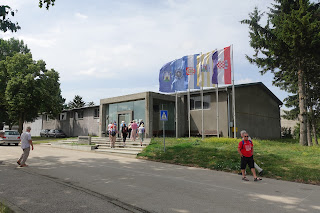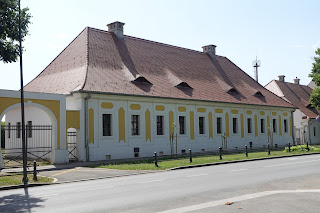Vukovar, Croatia
Vukovar is located where the Vuka River joins the Danube. After the First Word War, Hungary lost much of its territory and several new or enlarged states emerged. Croatia was established and became an integral part within the Federal Republic of Yugoslavia.
The Eltz Manor castle in the city was built 1749 - 1751 by the House of Eltz and was enlarged and modified over time. The communists confiscated the castle in 1944 but it was finally returned to the family in 1990. It was badly damaged during the Croatian War of Independence. The castle is depicted on the Croatian 20 kroner banknote.
Some of the river traffic, a single tug pushing eight barges down river. There is some traffic but not nearly as much as I saw on the lower Rhine.
The water tower is an iconic symbol of the city.
There are 640 holes in the structure caused by Serbian attacks as they were eager to topple the tower as it was the symbol of Croatian resistance.The cross at the mouth of the River Vuka where it joins the Danube although it is so small that it is not navigable.
Hotel Danube, an eight storey building overlooking the Danube and it was on the front line. It was damaged during the siege and later was used as barracks for the occupying Serbian troops. However it has yet to find an alternative use. Some of the damage was repaired but people just didn't want to book a room there so it is empty and slowly deteriorating.
A memorial to the damage inflicted on the town. It is a series of house fronts at an angle to signify the damage imposed.
This is the former pharmacy at one end of the main shopping street. It has lost its roof and is dilapidated. The owner was offered a new flat but he refused. He regularly plants flowers in the window boxes as a sign of rebirth.
Two impressively restored buildings, the one on the right would figure later in the post.
Another impressively restored building.
One of the former wine barrels from a major local wine producer now being used as a pub table but the name is still clear, Ilocki Podrumi who produce more than 5 million bottles of wine a year. The company provided 11,000 bottles of their Gurwirtztraminer wine for Queen Elizabeths coronation and it still regularly provides wine for the royal household.
The former palace of the ruler of the area, converted into a beer hall by the communists.
Its lower windows along one side show scenes of the city from postcards prior to its destruction. The building on the left has been destroyed but the one on the right is the same one that has been restored shown just four pictures up.
This is the memorial to the worst war crime committed during the Fight for The Homeland when Serbia invaded in 1991. Shortly after the 85 day siege and capitulation of Vukomvar, the hospital staff, civilian patients and injured soldiers numbering 261 were taken from the local hospital to a remote farm. They were tortured and executed and buried in several mass graves.
A detail of the floor with cartridge cases embedded in the concrete.
A memorial to the massacred in front of the memorial building. Some 61 bodies are still not accounted for and are still waiting to be found.
The spire of the Franciscan monastery overlooking the city and our last stop.
A view of our ship moored below the monastery. The names of the more than 2,700 people who died in the city during the war are recorded on the terrace overlooking the river. We saw a film of the troubles taken at the time and it was very moving, o similar to seeing footage of Jews being marched to the death camps by the Nazis fifty years before but in colour and just thirty years ago and ethnic cleansing and alleged liberation to justify their actions happening again in Ukraine today.
The inner courtyard.
The church spire from the inner courtyard.
One of the side altars.
The Scar of Vukomvar. The monastery was badly damaged but has been extensively repaired but this area only received minimal restoration as a memorial to the death and destruction from the four year war starting in 1991.
The main organ.
The main altar. The monks and townspeople are proud of the church as it is the third longest in the country at 58 metres.
A view of the damage at the end of the war. The Serbian forces were preparing to blow up the ruins as they retreated and were drilling holes in the masonry to place explosive charges. American General Jean Paul Klein heard about the plan and moved his soldiers into the city to stop the Serbians so that there was something to salvage after the war..
A view of Castle Eltz which is definitely not a castle but a palace.
The main entrance.
One of the wings at the back of the main palace overlooking the Danube. The city was hosting a film festival and this was one of several locations to host guests and hence the mass of chairs.
A view of the back of the palace overlooking the Danube.
...an oven in lieu of a fireplace in one room...
...part of the ground floor, wonderfully cool in the heat of the day with arched ceilings...
...a mirror and entrance to a reception room with beautiful marble flooring...
...an ethnological display very similar to the one we had seen the day before in Kalocsa...
... and a collection of dozens of traditional costumes...
...and yet more.
Along the road were some municipal offices of the local Symeia district.But where ever you went there were empty and damaged buildings...
...and some in worst states of repair without a rook with empty plots beside them that had been cleared and laid to grass but some modern building is taking place such as the tower block in the background as people have to have somewhere to live.








































No comments:
Post a Comment